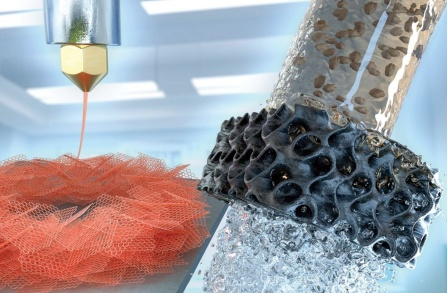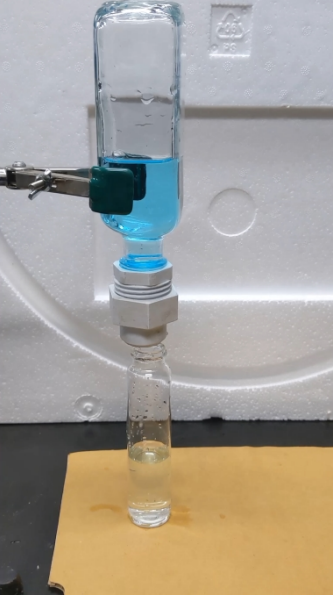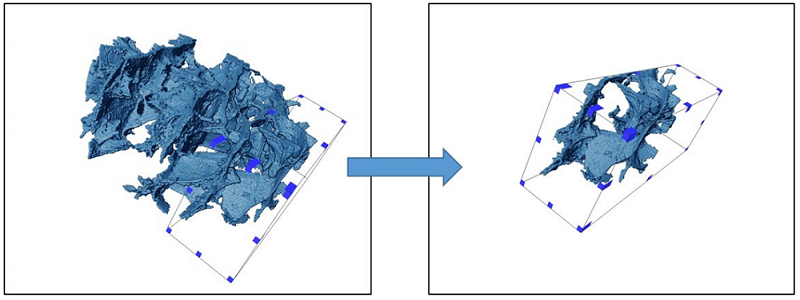Aerogels, formed by replacing the liquid in a gel material with a gas so the solid remains the same size, are extremely porous, lightweight yet strong solids, not dissimilar in structure to Styrofoam. The nanomaterial graphene is made of a single flat sheet of elemental carbon atoms that are arranged in a repeating hexagonal lattice shape. These two materials are pretty different, but they’re both often used in 3D printing applications, and sometimes they’re even combined, particularly for use in the energy sector. But now, a team of University at Buffalo (UB) engineers are using 3D printed graphene aerogels for water treatment. The team published a paper on their work, titled “3D printed graphene-biopolymer aerogels for water contaminant removal: a proof of concept,” that discusses their new process for printing the graphene aerogels that offers a stable, scalable solution for water treatment.
If you’re like me, then you weren’t aware that graphene, often touted as something of a “wonder material,” is great at removing contaminants from water, especially when paired with aerogels. Unfortunately, the solution just isn’t commercially viable, due to the large-scale manufacturing setup that would be needed for it to to work in water treatment plants.
But the UB research team has come up with a proof of concept that uses direct ink writing (DIW) 3D printing, followed by freeze-drying, to prepare graphene-biopolymer aerogels for successful water treatment.
“The goal is to safely remove contaminants from water without releasing any problematic chemical residue. The aerogels we’ve created hold their structure when put in water treatment systems, and they can be applied in diverse water treatment applications,” explained Nirupam Aich, PhD, assistant professor of environmental engineering at the UB School of Engineering and Applied Sciences and a co-author of the study.
Aich is actually part of a collaboration between UB and the University of Pittsburgh that’s working to find methods and tools that can be used to degrade toxic per- and polyfluoroalkyl substances (PFAS), which are often referred to as “forever chemicals” due to how difficult they are to break down. Mentioning in a press release that the work is similar to this research on 3D graphene aerogels, Aich hopes that the results of both can be used together in order to “create more effective methods of removing waterborne contaminants.”

This illustration depicts, L-R, a 3D printer printing the hexagonal-shaped graphene aerogel sheet, and the aerogel (now black) filtering dirty water. Credit: Environmental Science: Nano+
“We can use these aerogels not only to contain graphene particles but also nanometal particles which can act as catalysts. The future goal is to have nanometal particles embedded in the walls and the surface of these aerogels and they would be able to degrade or destroy not only biological contaminants, but also chemical contaminants,” Aich said.
The UB team needed to create ideal consistency for the graphene ink, and added it to two bio-inspired polymers—synthetic polydopamine (PDA) and bovine serum albumin (BSA)—to achieve, as they explain in the paper, “appropriate rheology for DIW printability.” They characterized the aerogel’s physiochemical properties all the way from the nano- to the macroscale, and found in tests that the 3D printed material was able to successfully remove certain heavy metals, like lead and chromium, that are often a problem in drinking systems. In batch absorption studies, the 3D printed graphene aerogel also removed organic solvents like heptane, hexane, and toluene, as well as organic dyes, such as cationic methylene blue and anionic Evans blue.
“The electrostatic interaction dominated the removal of heavy metals and dyes while the hydrophobic interaction dominated the removal of organic solvents from water. Moreover, the aerogel showed superb regeneration and reuse potential. The aerogel removed 100% organic solvents over 10 cycles of regeneration and reuse; additionally, the removal efficiencies for methylene blue decreased by 2–20% after the third cycle. The fit-for-design 3D printed aerogel was also effectively used as a bottle-cap flow-through filter for dye removal,” the researchers wrote.
Aich also explained that the aerogels, which don’t leave behind any residue in the water and can also be reused in other places, are able to be printed in larger sizes than nanosheets, which means the process could potentially be used in large facilities, like water treatment plants.
“The potential and vision of the 3D printing approach for graphene-based water treatment presented here can be extended to other functional nanomaterials, can enable shape-specific applications of fit-for-purpose adsorbents/reactors and point-of-use filters, and can materialize the large-scale manufacturing of nano-enabled water treatment devices and technologies,” the researchers concluded.
UB, which has filed a patent application for its 3D printed graphene aerogel, is now looking for industrial partners who can help commercialize this process.
(Source/Images: University at Buffalo)
Subscribe to Our Email Newsletter
Stay up-to-date on all the latest news from the 3D printing industry and receive information and offers from third party vendors.
You May Also Like
Further Understanding of 3D Printing Design at ADDITIV Design World
ADDITIV is back once again! This time, the virtual platform for additive manufacturing will be holding the first-ever edition of ADDITIV Design World on May 23rd from 9:00 AM –...
3D Printer Maker EVO-tech Reborn as NEVO3D — Once More With Feeling
EVO-tech was a 3D printing service and original equipment manufacturer established in 2013 and based in Schörfling am Attersee, Austria. The company produced high-quality material extrusion systems featuring linear bearings,...
3D Systems Brings 3D Printed PEEK Cranial Implant to the U.S. with FDA Clearance
For more than 10 years, 3D Systems (NYSE:DDD) has worked hand-in-hand with surgeons to plan over 150,000 patient-specific cases, and develop more than two million instruments and implants from its...
CDFAM Returns to Berlin for Second Annual Symposium
The second CDFAM Computational Design Symposium is scheduled for May 7-8, 2024, in Berlin, and will convene leading experts in computational design across all scales. Building upon the first event...



































